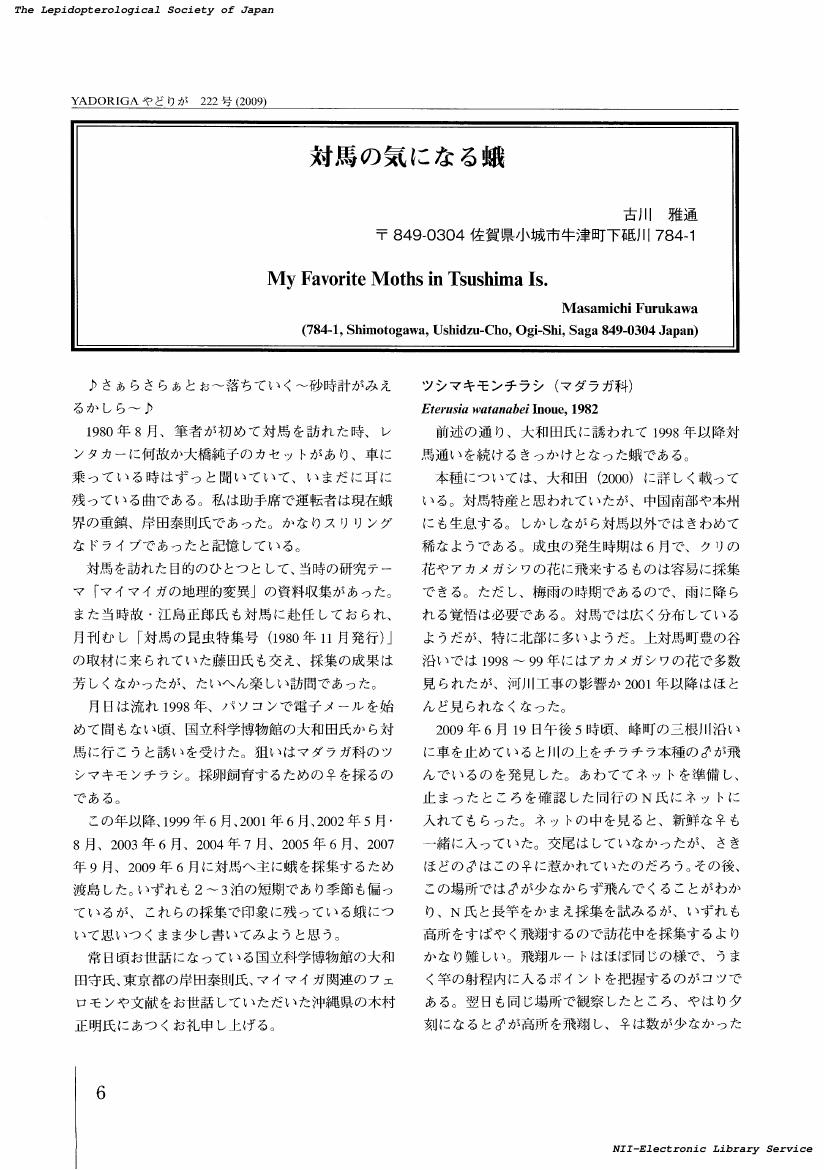1 0 0 0 OA 法学会記事(2010年度分)
- 出版者
- 南山大学法学会
- 雑誌
- 南山法学 = Nanzan Law Review (ISSN:03871592)
- 巻号頁・発行日
- vol.34, no.3-4, pp.239-240, 2011-03-31
1 0 0 0 創始期ラジオドラマとラジオドラマの「ことば」研究
1 0 0 0 称名寺貝塚 : 土器とイルカと縄文人
- 著者
- 横浜市歴史博物館編
- 出版者
- 横浜市歴史博物館 : 横浜市ふるさと歴史財団
- 巻号頁・発行日
- 2016
1 0 0 0 OA ニュージーランドにおけるインクルージョン研究 : 権利擁護機関としての「SES」
- 著者
- 八巻 正治
- 出版者
- 日本ニュージーランド学会
- 雑誌
- 日本ニュージーランド学会誌 (ISSN:18839304)
- 巻号頁・発行日
- vol.5, pp.90-101, 1999-06-10 (Released:2017-04-15)
1 0 0 0 中國古代における文法的説明による論證とその形式
- 著者
- 近藤 浩之
- 出版者
- 北海道中国哲学会
- 雑誌
- 中国哲学 (ISSN:02871742)
- 巻号頁・発行日
- no.37, pp.1-54, 2009-11
1 0 0 0 OA 井上円了の『外道哲学』
1 0 0 0 OA 韓国 児童手当法の制定
- 著者
- 藤原夏人
- 出版者
- 国立国会図書館
- 雑誌
- 外国の立法 : 立法情報・翻訳・解説 (ISSN:13492071)
- 巻号頁・発行日
- vol.(月刊版. 276-2), 2018-08
1 0 0 0 OA 2018年の香港特別行政区 独立派への強硬路線の継続と米中貿易戦争の影
- 著者
- 倉田 徹
- 出版者
- 独立行政法人 日本貿易振興機構アジア経済研究所
- 雑誌
- アジア動向年報 (ISSN:09151109)
- 巻号頁・発行日
- vol.2019, pp.151-170, 2019 (Released:2019-10-24)
1 0 0 0 OA 鳥類名纂
- 著者
- 脇山 三彌
- 出版者
- 日本鳥学会
- 雑誌
- 鳥 (ISSN:00409480)
- 巻号頁・発行日
- vol.2, no.8, pp.216-218, 1919-07-21 (Released:2009-02-26)
1 0 0 0 宮の構造と政務運営法 : 内裏・朝堂院分離に関する一考察
- 著者
- 古瀬 奈津子
- 出版者
- 公益財団法人 史学会
- 雑誌
- 史学雑誌 (ISSN:00182478)
- 巻号頁・発行日
- vol.93, no.7, pp.1147-1183,1290-, 1984
<p>One of the more important changes which occurred in the structural plan of various imperial palaces (including the Nara palace) in ancient Japan before the construction of the Nagaoka palace in 784 is the transformation from the straight line alignment of the tenno's residence (dairi 内裏), the great hall of government (dai-goku-den 大極殿) and the government ministries (chodoin 朝堂院) to an arrangement separating the dairi and the chodoin. Previous research dealing with this change has asserted that it was brought about by the insistence on a separation of private and public interest within the government. However, such a hypothesis has yet to be proven. This essay attempts to re-investigate the related source materials and look at the problem more fundamentally. Within the Nara palace (Heijo-kyu 平城宮), 1)the palace floor plan in the same way as the former palaces of the Asuka region was designed so that every morning court status holders could gather before the tenno in the great hall, and then begin their government duties ; 2)according to Nara period law codes, the daigoku-den's gate was kept open while bureaucrats went about their duties in the chodoin ; 3)a comparison of the fifth article in the code for court decorum within the T'ang and Japanese systems shows that the Japanese code does not follow the Chinese precedent of scheduling bureaucrats' morning attendance in the great hall according to status category, indicating that functionally the daigoku-den and the dairi were yet unseparated. Therefore, we can say that from the viewpoint of the tenno, the daigoku-den functioned not only as a ceremonial place, but also as a place where the daily government duties were performed. However, according to a document reporting an imperial edict (senji 宣旨) dated 792 (Enryaku 延暦 11), a significant change in the above related custom occurred. In this document the tenno recognized the number of days which those central government bureau (dajokan 太政官) officials of fifth rank and above were to carry out their duties in the dairi. Therefore, after 792 the auditorium of the dairi became the location of the tenno's daily affairs, while the chodoin became the place where the tenno would appear for state ceremonies only. This functional specialization may be thought of as corresponding to the structural separation of the dairi and chodoin. Such a change was reflected in the plan of the Heian palace built in Kyoto in 794. As the tenno came to supervise the affairs of government in the dairi through councilors of state in the dajokan (sangi 参議) who were permitted certain work days in his presence, the rules of execution for the bureaucracy also went through various changes. First, the ceremony for reporting administrative affairs (kosaku 告朔) to the tenno in the chodoin, a ceremony which was held monthly until the end of the Nara period, became during the Heian period a symbolic ritual which was carried out at the beginning of each of the four seasons; and administrative monthly reporting was done through documents sent from various offices to dajokan. Secondly, during the Nara period on the day of the kosaku ceremony, the four member management staff (shitokan 四等官) of each office would report to the tenno their number of work days. However, from 809 (Daido 大同 4) those monthly reporting to the tenno were limited to the sangi and above. Thirdly, there was the creating of the very important position of geki 外記, the secretary of this privy council. In this way the bureaucracy, which had previously been thought of as officials "directly at hand" due to the fact of the tenno's daily appearance in the great hall, came to be considered in a more conceptual way as the mechanism consisting of administrative offices, dajokan and tenno. In other words, up until the abandonment of the Nara palace, the tenno appeared daily in the daigoku-den to supervise the affairs of</p><p>(View PDF for the rest of the abstract.)</p>
1 0 0 0 講座東洋思想
- 著者
- 宇野精一, 中村元, 玉城康四郎 編
- 出版者
- 東京大学出版会
- 巻号頁・発行日
- vol.第4, 1967
1 0 0 0 OA 台湾産アゲハモドキガ科の生活史
- 著者
- 顔 聖紘 穆 家宏 〓 家龍 吉本 浩
- 出版者
- THE LEPIDOPTEROLOGICAL SOCIETY OF JAPAN
- 雑誌
- 蝶と蛾 (ISSN:00240974)
- 巻号頁・発行日
- vol.46, no.4, pp.175-184, 1995-12-10 (Released:2017-08-10)
- 参考文献数
- 21
台湾には2種のアゲハモドキ(Epicopeia mencia Moore,オナガアゲハモドキとE.hainesii matsumurai Okano,アゲハモドキ)が分布する.それらは日本や中国で生活史が分かっているものの,台湾では充分に調べられていなかった.私達は1992年から1993年にかけて,これら両種の台湾での生活史を調べることができたので,ここに報告した.Epicopeia mencia Mooreオナガアゲハモドキ食樹はニレ科のアキニレ.これは中国および日本(対馬)で知られる食樹と同じである.卵は食樹の葉の裏面にまとめて産み付けられ,幼虫は終齢(6齢)まで白色の蝋状物質をまとう.蛹化は白い蝋物質で覆われた柔らかい繭内で行なわれる.成虫は4月から10月まで見られ,年2-3化.台湾全土の標高500-2,000mまでの常緑カシ帯に分布するが,食樹の分布に限定されて局所的である.Epicopeia hainesii matsumurai Okanoアゲハモドキ私達の確認した食樹はミズキ科のミズキ,クマノミズキ,ヤマボウシで,日本での記録と同じである.卵は,前種同様,食樹の葉裏にまとめて産み付けられ,前種よりやや小さい.幼虫は終齢(6齢)まで白色の蝋状物質をまとうが,3齢以降の蝋物質の分泌は前種よりも多く,いくつかの体節では細い毛束状,蛹は前種よりもスマートである.成虫は4月から10月まで見られ,年2化.台湾の北部,中部,東部の標高500-2,000mまでのいくつかの産地に限って分布する.
1 0 0 0 OA 日本・韓国・台湾のアゲハモドキ属
- 著者
- 井上 寛
- 出版者
- 日本鱗翅学会
- 雑誌
- 蝶と蛾 (ISSN:00240974)
- 巻号頁・発行日
- vol.29, no.2, pp.69-75, 1978-06-01 (Released:2017-08-10)
Okano[岡野磨瑳郎]は,台湾産のタイワンアゲハモドキの学名を論じ(1958,1964),学名はEpicopeia formosana Nagano, 1912(=E. hirayamai Matsumura, 1935)とすべきであるという結論に達し,さらに第3の論文(1973)では,E. formosanaのなかで,前後翅に白帯のあるのがf. formosana,白帯のないのがf. hirayamaiとした.また第3の論文では,E. hainesii Hollandアゲハモドキの台湾亜種matsumurai okanoを記載し,そのなかで,ジャコウアゲハの♀のように翅の白っぼい型をf. albaと名付けた.私は以前から,日本,朝鮮,台湾などに産するこの属の種や亜種に関心をもち,標本や文献を集めてきたし,British Museum (Natural History) (以下BMNHと略す)では,タイプ標本を含め,多数のシナ産の標本を検することができたので,Okanoがまったく言及していない文献や大陸の標本を含めて,2種の学名や地理的変異についての私見を述べることにした.
1 0 0 0 OA 対馬の気になる蛾
- 著者
- 古川 雅通
- 出版者
- 日本鱗翅学会
- 雑誌
- やどりが (ISSN:0513417X)
- 巻号頁・発行日
- vol.2009, no.222, pp.6-11, 2009-11-10 (Released:2017-08-19)
- 参考文献数
- 8
1 0 0 0 名探偵コナン 紺青の拳(フィスト)
- 著者
- 戸川 芳郎
- 出版者
- 理想社
- 雑誌
- 理想 (ISSN:03873250)
- 巻号頁・発行日
- no.397, pp.8-25, 1966-06




